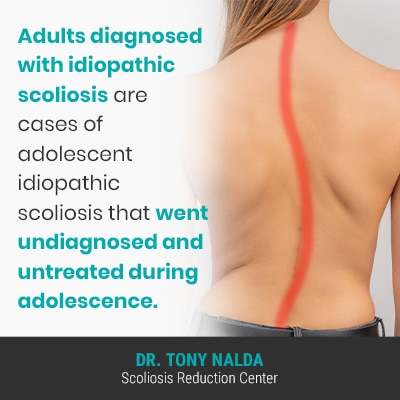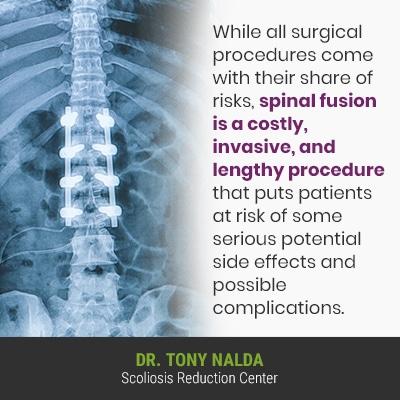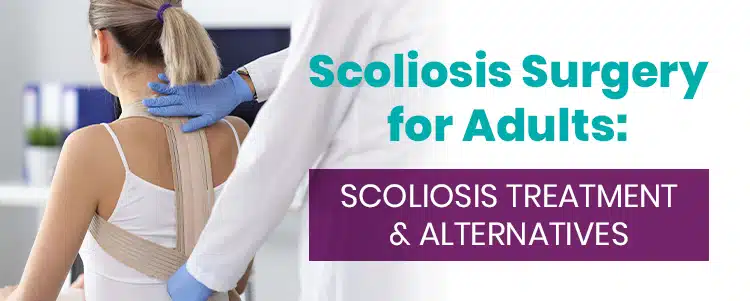There are several goals to treating adult scoliosis: reducing the curve, pain relief, stabilizing the spine, and increasing core strength so the spine is optimally supported by its surrounding muscles. While scoliosis surgery can help with straightening a crooked spine, it can cost the spine in terms of its natural strength and function.
While scoliosis is more prevalent in children and adolescents, it also affects adults. When it comes to adult scoliosis, treatment options vary, depending on the treatment approach chosen; there are both surgical and non-operative treatment options.
In addition to discussing scoliosis surgery for adults, let’s touch on the two main types of scoliosis to affect adults.
Adult Scoliosis
Being diagnosed with scoliosis means an unnatural spinal curve, with rotation, has developed, and it’s the rotational component that makes scoliosis a 3-dimensional condition.
In addition, a measurement known as Cobb angle is needed to reach an official scoliosis diagnosis, and the higher a patient’s Cobb angle, the more severe the condition, and when it comes to scoliosis surgery, condition severity is a key condition characteristic:
- Mild scoliosis: Cobb angle measurement of between 10 and 25 degrees
- Moderate scoliosis: Cobb angle measurement of between 25 and 40 degrees
- Severe scoliosis: Cobb angle measurement of 40+ degrees
- Very-severe scoliosis: Cobb angle measurement of 80+ degrees
A patient’s Cobb angle is measured during X-ray by drawing lines from the tops and bottoms of the curve’s most-tilted vertebrae; the intersecting angle is expressed in degrees.
An important feature of scoliosis to understand is that it’s progressive in nature, meaning it will get worse over time, particularly if left untreated, or not treated proactively.
So where a scoliosis is at the time of diagnosis is not indicative of where it will stay; only proactive treatment can counteract the progressive nature of scoliosis.
Being proactive with treatment can mean preventing progression, increasing condition severity, escalating symptoms, and the need for more-invasive treatment in the future.
In addition to different severity levels, there are also multiple condition types, and scoliosis, while more prevalent in children and adolescents, also affects adults.
The most prevalent condition type is adolescent idiopathic scoliosis, diagnosed between the ages of 10 and 18, and the idiopathic designation means not clearly associated with a single-known causative source.
In fact, 80 percent of known scoliosis cases are classified as idiopathic, while the remaining 20 percent are associated with known causes: neuromuscular, congenital, degenerative scoliosis, and traumatic scoliosis.
Idiopathic scoliosis is the most common type to affect adults.
Adult Idiopathic Scoliosis

Adults diagnosed with idiopathic scoliosis are cases of adolescent idiopathic scoliosis that went undiagnosed and untreated during adolescence.
The reality is that had these adults been diagnosed during adolescence, when the condition was at its mildest, their spines would have been in better shape than by the time they see me for a diagnosis and treatment.
It might seem difficult to imagine how an unnatural sideways spinal curve could go unnoticed until adulthood, but it’s quite common.
While no one wants to experience pain, it does serve a vital purpose of telling us something is wrong inside the body, and scoliosis isn’t known as painful for children and adolescents, as scoliosis doesn’t become a compressive condition until adulthood.
It’s compression of the spine and its surrounding nerves and muscles that causes the majority of condition-related pain, and in growing spines, the constant lengthening motion counteracts the compressive force of the unnatural spinal curve, which is why adult patients experience pain very differently.
In fact, pain is the primary symptom of scoliosis in adults, which is why pain management is a focus of adult scoliosis treatment, while postural deviation is the main scoliosis symptom in children and adolescents:
- Uneven shoulders with one sitting higher than the other
- Uneven shoulder blades with one protruding more on one side than the other
- Development of a rib arch
- Uneven waistline
- Uneven hips (one appears flatter and/or more rounded than the other
- Arms and legs that appear to hang at different lengths
Basically, any signs that the body’s overall symmetry has been disrupted can be an indicator for scoliosis in adolescents, in addition to ill-fitting clothing, and changes to balance, gait, and coordination.
In addition, particularly in cases of mild adolescent idiopathic scoliosis, functional deficits are rare, and the condition’s early telltale signs (uneven shoulders and hips) can be subtle and difficult for anyone, other than a scoliosis expert, to recognize.
When its symptoms are mild, early detection of adolescent idiopathic scoliosis can be a challenge, and with time and maturity, progresses into adulthood, until it becomes compressive and starts to produce noticeable symptoms that lead to a diagnosis and treatment.
Adult Idiopathic Scoliosis Treatment Success Story
Alisha’s scoliosis story highlights how the complex treatment needs of scoliosis are beyond the scope of general chiropractic.
After being diagnosed with adolescent idiopathic scoliosis in junior high school, Alisha was given a surgical recommendation, but was concerned about the invasiveness and uncertain results.
Alisha spent years trying to impact her condition with general chiropractic, and while certain adjustments could bring temporary pain relief, the condition wasn’t being impacted on multiple levels, as it needs to be, for sustainable long-term results.
After finding the Scoliosis Reduction Center® and trying scoliosis-specific chiropractic, plus the benefits of other forms of effective treatment, Alisha was finally able to reduce her curve on a structural level for long-term results that changed her life, allowing her to be the person she was meant to be.
After idiopathic scoliosis, the next most prevalent condition type to affect adults is degenerative scoliosis, also known as de novo scoliosis, meaning the condition has developed fresh in adulthood, with no prior history.
Adult Degenerative Scoliosis
Adult degenerative scoliosis develops over time and is most common in adults over the age of 40.
Caused by natural age-related spinal degeneration, it’s most often the spine’s intervertebral discs that are the first spinal structures to deteriorate.
The spine consists of vertebrae (bones of the spine) stacked on top of one another in a straight and neutral alignment, and adjacent vertebrae are separated by an intervertebral disc.
The discs provide the spine with structure (adjacent vertebrae attach to the disc in between), act as its shock absorbers, and combine forces to facilitate flexible movement.
The spinal discs are also the largest structures inside the body without their own vascular supply, meaning no direct path in and out of the discs through which important nutrients needed for repair can pass; this is why the degenerative process is difficult, and lengthy, to reverse.
In addition to natural age-related spinal degeneration, the cumulative effect of certain lifestyle choices can exacerbate the rate of degeneration: carrying excess weight, chronic poor posture, leading a sedentary lifestyle, and repeatedly lifting heavy objects incorrectly.
Degenerative scoliosis is more prevalent in women than men, and this is related to bone density and hormone changes caused by menopause.
Adult Degenerative Scoliosis Treatment Success Story
Denise’s story is one I’ve heard many times. Diagnosed with degenerative scoliosis and struggling with back pain for years, Denise was told simply that her pain was part of aging.
As an active individual, Denise couldn’t accept that there was nothing to be done to improve her current, and future, quality of life.
Denise advocated for herself and found the Center on her own. Treating adult scoliosis is a different process than with younger patients; once skeletal maturity has been reached, related compression becomes a problem and can cause varying levels of back and/or radicular pain.
Here at the Center, with many of my adult scoliosis patients, the goal of treatment is not to reduce a scoliotic curve down to zero, as we often try to do with younger patients, but rather to reduce a scoliotic curve back down to where it was prior to causing noticeable symptoms, like pain.
Denise was thrilled with her reduction results of 31 degrees down to 24, and has since been able to take part in many of the activities her scoliosis had kept her from prior to conservative treatment.
Now that we’ve covered the two most-prevalent types of scoliosis, plus provided examples of non-surgical treatment success stories, let’s talk about adult scoliosis treatment options.
Adult Scoliosis Treatment Options
There are two main scoliosis treatment approaches for patients to choose between: traditional and conservative treatment.
I want patients to be aware of the differences between the two approaches because they offer patients different potential outcomes that can affect quality of life.
As a progressive condition, it’s important to start treatment as close to the time of diagnosis as possible, and this is because the condition is easiest to treat when it’s at its mildest, before spinal rigidity has increased with progression, making the spine less responsive to treatment, and before the body has had ample time to adjust to the unnatural spinal curve’s presence.
While conservative treatment values being proactive and working towards corrective results, traditional treatment is more reactive and focuses on stopping progression.
Traditional Surgical Treatment of Adult Scoliosis
Traditional treatment was the dominant choice for many years, and this approach focuses on pain management and stopping progression through spinal surgery.
Pain management can include a combination of pain medication, anti-inflammatory steroid injections, and bracing, but this treatment is only addressing symptoms of scoliosis, and not the scoliosis itself: the underlying cause of pain.
In addition, traditional bracing, of which the most commonly used is the Boston brace, is associated with a number of shortfalls:
- Only addressing the condition as 2-dimensional (ignoring its rotational component)
- Squeezing the spine unnaturally from the sides, known to weaken it over time
- Mass produced braces make them uncomfortable and bulky to wear
- Compliance issues
- Has stopping progression, not correction, as its end goal

While all surgical procedures come with their share of risks, spinal fusion is a costly, invasive, and lengthy procedure that puts patients at risk of some serious potential side effects and possible complications.
Because the end goal of spinal fusion is preventing further progression, achieving corrective results on a structural level, without surgery, is beyond the scope of traditional treatment.
Surgical Treatment of Adult Scoliosis
Spinal fusion surgery commonly involves fusing the most-tilted vertebrae of the curve into one solid bone; this is done so that movement in the fused section of the spine is eliminated and progression is stopped.
Often, rods are attached to the spine with pedicle screws to hold it in place, but holding the spine in place by artificial means is not the same as achieving corrective results on a structural level.
In addition, adult scoliosis surgery comes with its share of heavy potential side effects, both short and long term.
While there are a number of factors that shape how a patient responds to spine surgery such as patient age and overall health, condition severity, and the number/location of vertebrae fused, the following risks are associated with the procedure itself:
- Nerve damage
- Excessive blood loss
- Pain at the fusion site
- Risk of infection
- Adverse reaction to hardware
While not everyone is going to experience the above complications, the risk is there so should be considered carefully.
In addition, while there is a significant gap in the research/data on the long-term effects of living with a fused spine 20, 30, 40+ years in the future, known long-term side effects can include:
- Nerve damage
- Hardware failure
- Pain at the fusion site
- Loss of spinal flexibility and range of motion
- A spine that’s weaker and more vulnerable to injury
While some patients still maintain enough flexibility above and below the fused section to not notice a significant loss in spinal flexibility and range of motion, many patients are disappointed with this effect.
If there is any type of hardware malfunction, additional surgery is the only recourse, and the chances of such complications only increase with age.
As the spine is held in place, the loss of movement means excessive spinal rigidity, and this also affects its surrounding muscles, and many patient’s pain increases as a result of the stiff and strained spine and muscles.
In addition, this can impact quality of life as it can lead to certain activity restrictions and/or the inability to participate in once-loved activities, and the knowledge that a person’s spine is weaker and more vulnerable to injury can make some fearful of trying new things.
After all, the spine’s natural curves make it stronger, more flexible, and better able to absorb/distribute mechanical stress incurred during movement, so because the spine is held artificially in place, instead of restoring its natural curves, it’s overall health and function won’t be the same as pre-surgical treatment.
One of the main shortfalls of traditional scoliosis treatment for adults, in general, is that it doesn’t address the condition’s true 3-dimensional nature, limiting its potential efficacy.
Remember, scoliosis isn’t just an unnatural sideways curve of the spine; it also twists from front to back, back to front, so for treatment to impact the entire spine, the condition has to be effective in all dimensions, as it is with conservative treatment for adult scoliosis.
Conservative Treatment for Adult Scoliosis
Here at the Scoliosis Reduction Center®, I treat patients with a conservative chiropractic-centered approach that values proactive treatment started as close to the time of diagnosis as possible.
I combine multiple scoliosis-specific treatment disciplines to impact the condition on every level.
As a structural condition, scoliosis has to, first and foremost, be impacted on a structural level, in the form of a curve reduction. We also work towards stabilizing the spine by improving core strength so the spine’s surrounding muscles can support it optimally.
Treatment plans are fully customized to address key patient/condition characteristics by combining chiropractic care, in-office therapy (physical therapy), corrective bracing, and custom-prescribed home exercises.
The bracing used in conservative treatments is corrective in nature, like the ScoliBrace, and addresses the condition’s true 3-dimensional nature.
When combined with other forms of effective treatment, corrective bracing can help adults manage their pain, support their spine, stabilize their spine, and augment corrective results achieved through other disciplines.
The end goal of conservative treatment for adult scoliosis is to address the underlying cause of pain: the spinal imbalance making it more prone to degenerative changes, by impacting the condition structurally.
As adult scoliosis tends to progress at slower rates than adolescent scoliosis, our treatment options can work towards achieving curvature reductions over time, as they can relieve pain simultaneously and prevent the need for invasive spine surgery in the future.
In adolescent scoliosis, a major focus has to be on achieving curvature reductions quickly in order to counteract the growth trigger for progression and hold a patient’s scoliosis where it is throughout growth.
My specific customized home-exercise program helps counteract the slow progressive nature of adult scoliosis and prevents the spine from degenerating further, which can greatly improve quality of life.
So let’s now address a common question regarding whether or not adult scoliosis can actually be corrected, and what exactly that means.
Can Adult Scoliosis be Corrected?
While there are benefits associated with early detection and proactive treatment, regardless of age, it’s never too late to start treatment.
When patients ask if adult scoliosis can be corrected, I assume they mean cured, and while we can achieve corrective results through a curvature reduction, scoliosis is incurable because of its progressive nature; however, scoliosis is highly treatable.
For an adult scoliosis treatment plan to be considered a success, a curvature reduction will have occurred, the spine’s stability is increased, progression is managed, and core strength is increased so the spine is optimally supported by its surrounding muscles.
While each case is as unique as the patient themselves, most often, work is needed to sustain those results, and this can take the form of periodic chiropractic sessions, monitoring for signs of progression, and a series of custom-prescribed exercises for establishing a home-rehabilitation program.
It’s important to understand, however, that while being diagnosed with a progressive and incurable condition like scoliosis can seem bleak, there are a number of successful adults living their best lives with scoliosis, proving that having scoliosis for life doesn’t equate to a life of limitations.
And the reality is that many cases of adult scoliosis will respond to nonsurgical treatments.
Conclusion
The Scoliosis Research Society puts current estimates at between six and nine million people currently living with scoliosis in the United States alone, and while many of these cases are adolescents, the actual rate of scoliosis increases with age.
Regardless of age or severity, the best time to start treatment is always now, and this is particularly true in cases of progressive conditions like scoliosis.
Here at the Center, I treat patients with a conservative treatment approach that values being proactive in preventing further spinal deterioration, reducing the curve back to where it was prior to becoming painful, and increasing core strength for optimal spinal support and stabilization.
The reality is that many cases of adult scoliosis can be treated non-surgically, and the benefit to non-surgical treatment is that, when successful, it preserves as much of the spine’s natural curves and function as possible.
In addition, while spinal surgery can be successful at straightening a crooked spine, it can come at the cost of the spine’s overall health and function, which can mean a different quality of life.
Adult spinal deformity surgery can come with risks of increasing pain at the fusion site, reduced spinal flexibility, a loss in range of motion, hardware failure, and a spine that’s weaker and more vulnerable to injury.
While not all patients will experience any of these adverse effects, the risk is there so should be considered carefully, and in addition, there are other less-invasive conservative treatment options available, with proven results.




